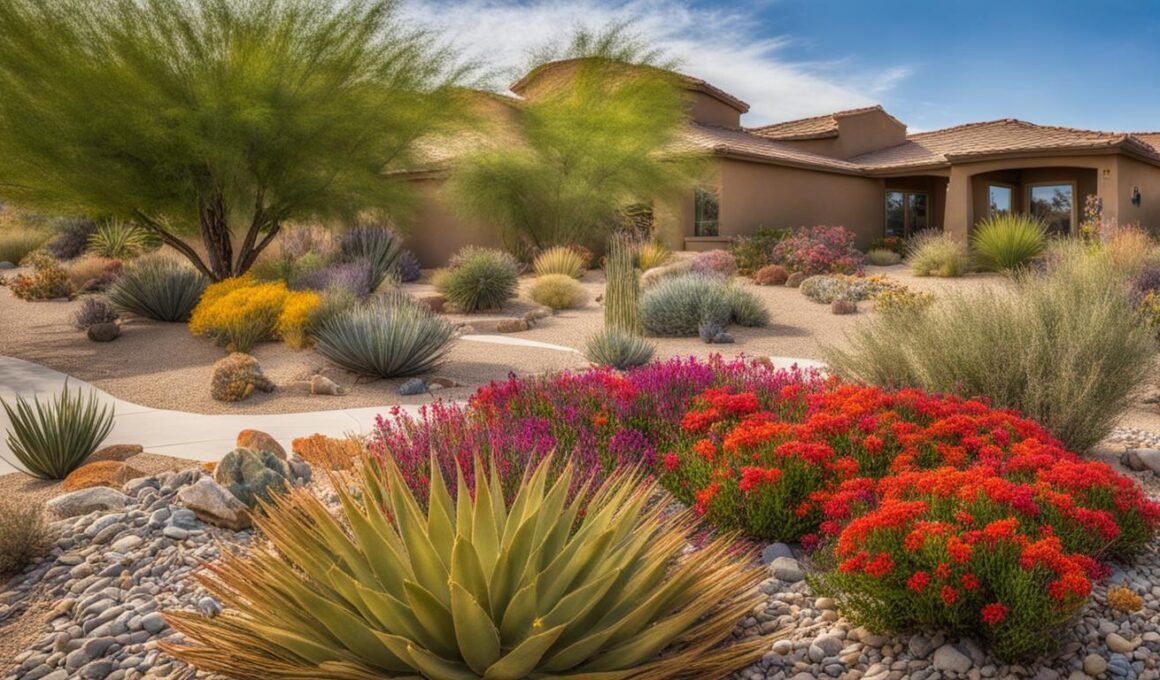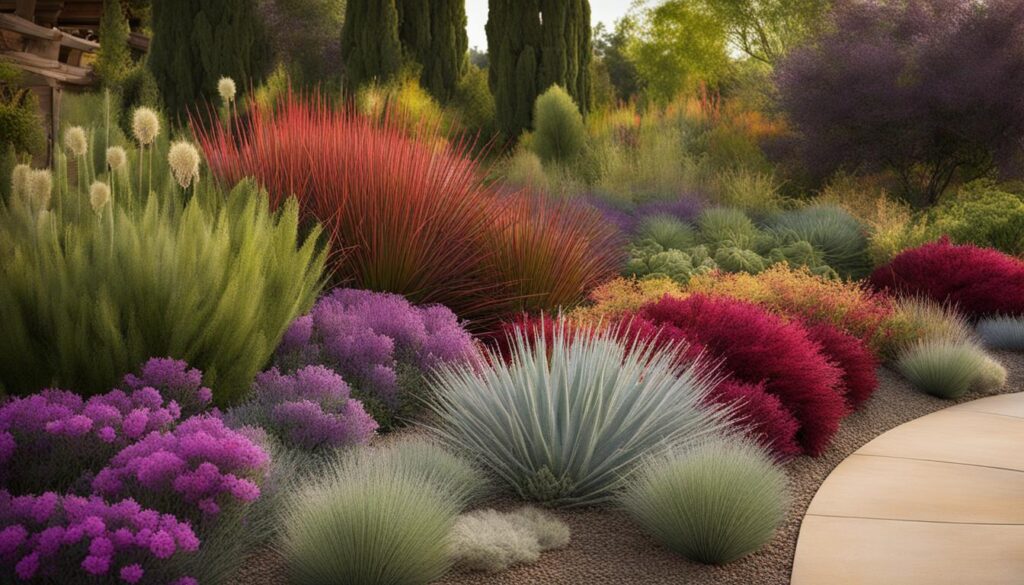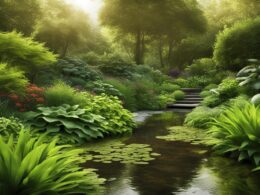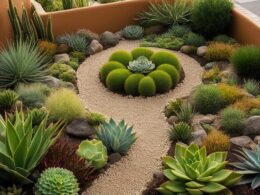When it comes to landscaping, incorporating vibrant seasonal colors can transform your outdoor space into a visual masterpiece. Xeriscape planning offers a unique approach to achieving this while also promoting eco-friendly practices. By carefully selecting and planting annual flowers, you can create a landscape that showcases a variety of colors throughout the year, all while conserving water and reducing maintenance.
Key Takeaways:
- Xeriscape planning involves selecting and planting annual flowers for seasonal color changes.
- Proper soil preparation, including the addition of organic matter, is vital for vibrant color areas.
- Fertilizer incorporation and weed control measures reduce maintenance and support healthy growth.
- Timing of planting and careful handling of transplants contribute to successful color changes.
- Mulching, deep watering, and regular maintenance enhance the appearance and health of the plants.
The Importance of Using Color in Landscape Design
When it comes to landscape design, color plays a crucial role in creating visual impact and enhancing the overall aesthetics of outdoor spaces. Incorporating seasonal color changes through the use of vibrant flowers can breathe new life into your landscape and make it visually stunning.
Color is a key design element that can add variety and interest to any landscape. It has the power to evoke emotions, create focal points, and guide the eye. By strategically planting annual flowers with different colors, you can create a dynamic and ever-changing landscape that captivates the senses.
“Color is a power which directly influences the soul.” – Wassily Kandinsky
Using color in landscape design can create focal points and guide the eye. For example, a burst of red flowers can draw attention to a specific area or highlight an architectural feature. On the other hand, a peaceful blend of pastel-colored flowers can create a calming and serene atmosphere.
The Visual Impact of Seasonal Color
By incorporating seasonal color changes, you can transform your landscape throughout the year and keep it fresh and exciting. Each season brings a new palette of colors, allowing you to create a visually appealing space that reflects the changing seasons.
Whether you opt for bold and vibrant hues or soft and delicate shades, seasonal color changes can have a profound impact on the overall look and feel of your landscape. It can create depth, dimension, and visual interest, making your outdoor space a true work of art.
So, don’t underestimate the power of color in landscape design. Embrace seasonal color changes, experiment with different palettes, and watch as your landscape comes to life with a beautiful symphony of colors.
Selecting the Right Plants for Seasonal Color Changes
When planning for seasonal color changes, it is crucial to choose the appropriate plants for your flower beds. The selection of plant material will depend on the number of change-outs scheduled in the contract. To achieve a visually stunning and diverse landscape, it is recommended to opt for different flowers that thrive in different seasons.
- Petunias: These vibrant flowers are excellent choices for adding color during the warmer months.
- Marigolds: Known for their bright orange and yellow blooms, marigolds can bring a touch of warmth to your landscape.
- Pentas: With their clusters of small, star-shaped flowers, pentas can add pops of color and attract butterflies and hummingbirds.
- Profusion Zinnias: These low-maintenance flowers come in a variety of colors and can bloom abundantly throughout the season.
- Vincas: Ideal for hot and dry climates, vincas boast vibrant flowers and glossy foliage.
- Violas: These cold-tolerant flowers are perfect for adding color to your landscape during the cooler months.
- Pansies: Pansies offer a wide range of hues, making them a popular choice for fall and winter displays.
- Snapdragons: These vertical blooms come in various shades and can add height and texture to your flower beds.
When selecting plants, consider incorporating a variety of colors and bloom styles. By working with an experienced professional in plant selection, you can ensure that your landscape showcases the best plants for seasonal color changes.
Quote:
“The right selection of plants can truly transform your landscape, providing a dynamic and ever-changing display of colors throughout the seasons.”
Using Color Schemes for Effective Seasonal Color Planning
When it comes to creating a visually stunning landscape design, color schemes play a crucial role in effective seasonal color planning. By carefully selecting and coordinating colors, you can create a harmonious and eye-catching display that enhances the beauty of your outdoor space.
One of the key considerations in using color schemes is understanding the different types available. Monochromatic color schemes use variations of a single color, creating a soothing and cohesive look. Analogous color schemes combine colors that are adjacent to each other on the color wheel, offering a harmonious and natural blend. Complementary color schemes utilize colors that are opposite each other on the color wheel, creating a bold and vibrant contrast. Primary color schemes focus on the three primary colors (red, blue, and yellow) and offer a classic and timeless appeal. Riotous color schemes involve using a mix of bold and contrasting colors for a vibrant and energetic effect. Lastly, pastel color schemes use soft and delicate hues for a gentle and calming look.
When implementing color schemes for seasonal color planning, it’s important to consider the overall landscape design and the desired visual impact. You can incorporate color schemes in various ways, such as using different color schemes for different flower beds or creating a sequence of color schemes that transition throughout the seasons. Additionally, don’t forget to leverage the power of foliage color. By incorporating plants with different foliage colors, you can add depth and interest to your landscape design.
Coordinating Colors and Plant Selection
When selecting plants for your seasonal color areas, it’s essential to consider how their colors will coordinate with the chosen color scheme. You can achieve a harmonious and cohesive look by selecting plants that align with the dominant colors of the scheme. For example, if you’re using a complementary color scheme with a combination of purples and yellows, choosing plants with purple and yellow blooms will create a visually pleasing display. Additionally, consider the intensity of the colors and the overall balance of the scheme.
Remember to also take into account the specific seasons when planning for color changes. Different plants bloom at different times of the year, so ensure that your plant selection aligns with the desired seasonal color transitions. Working with a seasoned professional can provide valuable guidance in selecting the right plants and coordinating colors to achieve the desired effect.
In conclusion, implementing color schemes in your seasonal color planning can elevate your landscape design and create a visually captivating outdoor space. By understanding the different types of color schemes and coordinating colors with plant selection, you can achieve a harmonious and aesthetically pleasing display that enhances the beauty of your landscape throughout the year.
How Can I Ensure Seasonal Color Changes in My Xeriscape Design?
To ensure yearround xeriscaping visual interest, incorporate plants with varying bloom times into your design. Select species that thrive in your climate to provide bursts of color throughout the seasons. Integrate evergreen trees and shrubs to maintain visual appeal during winter. Consider using hardscape elements like colored rocks or decorative structures to add texture and contrast.
Conclusion
Xeriscape planning for seasonal color changes is a smart and eco-friendly approach to enhancing the beauty of your landscape. By carefully selecting the right plants and implementing effective color schemes, you can create a stunning outdoor space that evolves with the seasons.
Remember to focus on important factors such as soil preparation, incorporating fertilizer, and controlling weeds to ensure the longevity and vibrancy of your seasonal color areas. You should also pay attention to the timing of planting and the proper handling of transplants to give your flowers the best chance to thrive.
Maintaining your seasonal color areas is crucial for long-term success. Regular manicuring and pest control measures will help keep your annuals in optimal condition, ensuring a beautiful landscape throughout the year. With the right planning and attention to detail, you can enjoy the ever-changing beauty of seasonal colors while conserving water and promoting sustainable landscaping practices.












